The Silent Crisis: Parental Burnout and Hidden Stress in Modern Families
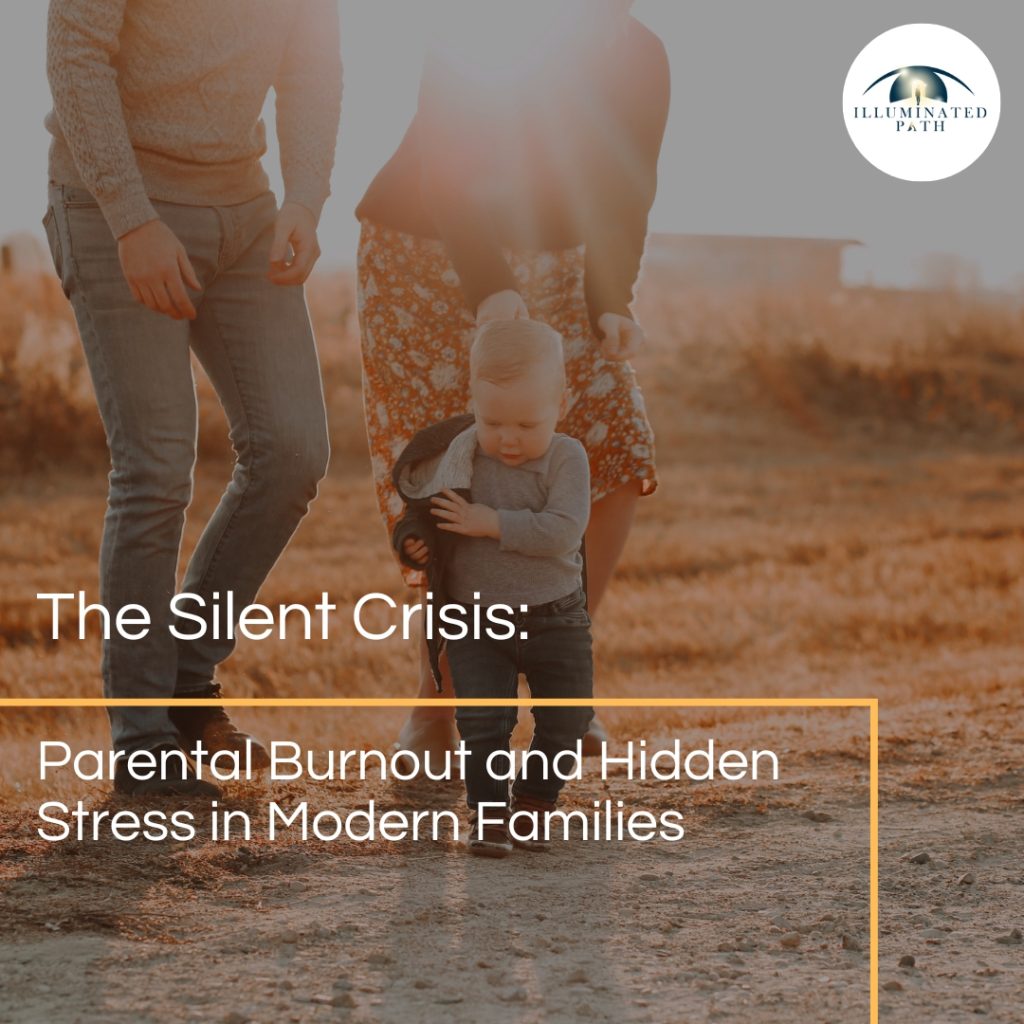
Modern parenting is often depicted as a journey filled with immense joy and profound love, yet beneath the surface of picture-perfect social media posts and well-meaning advice lies a reality often characterized by relentless demands and unspoken pressures. While the rewards of raising a family are undeniable, the daily grind can lead to a significant but frequently unacknowledged issue: parental burnout. This article aims to shed light on this silent crisis, defining what parental burnout is, exploring its widespread prevalence, detailing its often-overlooked symptoms, and delving into the complex web of causes, including societal expectations and the subtle stressors that permeate modern family life. Furthermore, it will analyze the far-reaching impact of this condition and offer pathways towards recovery through effective coping strategies and the supportive role of therapy. What Exactly is Parental Burnout? Parental burnout is characterized as a state of intense exhaustion specifically related to the role of being a parent. This isn’t merely feeling tired after a long day; it’s a profound and persistent weariness where even the thought of engaging in parenting responsibilities can feel utterly draining. At its core, parental burnout involves a combination of feeling overwhelmingly exhausted, experiencing emotional distancing from one’s children, and developing a sense of ineffectiveness in one’s parental capabilities. This condition arises as a prolonged response to the chronic stress inherent in raising children, often stemming from a long-term imbalance between the perceived risks or demands of parenting and the resources available to cope with them. When the scales tip, and the energy-consuming aspects of caregiving outweigh the replenishing ones, burnout becomes a significant risk. A crucial aspect of understanding parental burnout is recognizing the contrast between a parent’s current feelings and their previous experiences of parenting. Individuals experiencing burnout often recall a time when they felt more joy and fulfillment in their role, highlighting that this condition represents a deterioration from a prior, more positive state. This shift can be a key indicator, prompting parents to recognize that their current level of exhaustion and detachment is not their baseline. Several key characteristics define parental burnout: An overwhelming exhaustion specifically tied to the parental role , often described as a constant state of depletion that goes beyond typical tiredness. Emotionally, burned-out parents may experience a significant distancing from their children , where interactions become more about managing tasks than fostering emotional connection. They might feel mentally absent even when physically present. Furthermore, there’s often a profound sense of parental ineffectiveness , with parents doubting their capacity to be good caregivers and feeling a loss of accomplishment in their role. This can erode confidence and diminish the enjoyment derived from parenting. Beyond these core symptoms, other indicators can include an increase in addictive behaviors , the emergence of suicidal thoughts and escape fantasies , sleep disturbances and various health issues , heightened irritability and frustration , and a loss of motivation and interest in previously enjoyed activities. It is vital to distinguish parental burnout from regular stress and clinical depression. While parental burnout shares some similarities with both, it occupies a unique space. Parenting stress is a normal and expected part of raising children. However, burnout arises when this chronic stress becomes overwhelming, exceeding a parent’s coping abilities and often stemming from an imbalance between stressors and available resources. Unlike general stress, which can originate from various aspects of life, parental burnout is specifically linked to the sustained pressure of parenting. Depression, on the other hand, can manifest without a clear external trigger and often involves a broader range of symptoms, including pervasive low mood and a loss of interest across all areas of life. While burnout can unfortunately lead to depression, it is not caused by it. A key differentiator lies in the focus: parental burnout centers on exhaustion and detachment related to the demands of raising children, whereas depression encompasses a wider spectrum of negative feelings and experiences. The scope of negative feelings tends to be narrower in burnout, often primarily focused on the parental role. The Hidden Weight: Uncovering Subtle Stressors in Modern Families While the more overt causes of parental burnout, such as work-life imbalance and lack of support, are often discussed, several subtle and often overlooked stressors contribute significantly to this silent crisis in modern families. One of the most pervasive hidden stressors is the comparison culture that is rampant in today’s society, particularly amplified by social media. The constant exposure to curated, often unrealistic portrayals of other families and their seemingly perfect lives can leave parents feeling inadequate and constantly measuring themselves against an often-distorted reality. This pressure to “keep up with the Joneses” in the realm of parenting can be a significant source of stress. The societal emphasis on achievement and performance in children further fuels this comparison, creating an invisible pressure to ensure one’s children are excelling in all areas. Technology overload presents another subtle yet potent stressor. While technology offers numerous conveniences, its constant presence can blur the boundaries between work and family life, leading to an “always-on” mentality that prevents parents from truly disconnecting and recharging. Excessive screen time within families can also lead to decreased quality face-to-face interactions, hindering meaningful parent-child bonding and potentially increasing feelings of isolation among family members. Furthermore, disagreements over screen time limits and technology use can become a frequent source of conflict within households. Children may even sense and react to their parents’ preoccupation with technology, feeling like they are competing for attention. The often-invisible mental load of parenting is another significant contributor to hidden stress. This refers to the cognitive and emotional labor involved in managing a household and raising children – the constant planning, organizing, scheduling, and anticipating of everyone’s needs. This burden often falls disproportionately on one parent, typically the mother, leading to significant stress, burnout, and feelings of being overwhelmed and unappreciated, even when physical tasks are shared. The Scope of the Problem:
Designing a Healing Space: How Environment Impacts Mental Health
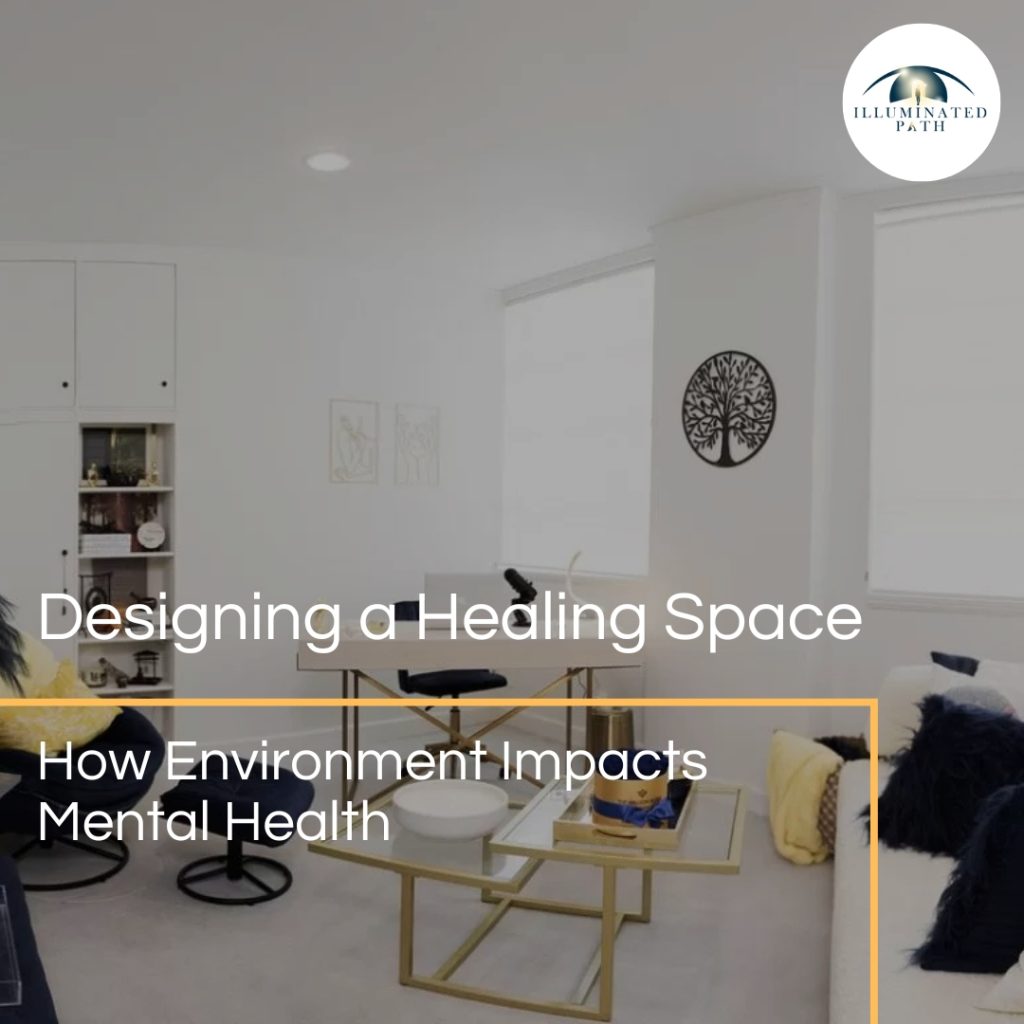
The spaces we inhabit are not passive backdrops to our lives—they actively shape our emotions, behaviors, and mental well-being. At Illuminated Path’s Therapy and Coaching Center, every therapy room is meticulously designed to foster emotional vulnerability, growth, and healing. Drawing on principles of environmental psychology, trauma-informed care, and evidence-based design, these spaces integrate sensory elements like lighting, comfort, and safety to create a sanctuary where clients feel empowered to confront their struggles. Below, we explore how intentional design choices transform physical environments into catalysts for mental health recovery. 1. Lighting: Balancing Calm and Connection Lighting is a cornerstone of healing environments. Illuminated Path prioritizes natural light, which helps regulate mood and reduce stress. Large windows with adjustable blinds allow clients to control sunlight exposure, fostering a sense of agency—a critical factor in trauma recovery. For evening sessions, warm, dimmable lighting mimics natural sunset hues, promoting relaxation. Harsh fluorescent lighting can exacerbate anxiety, so therapy rooms use indirect lighting sources, such as softly glowing wall sconces and table lamps, creating a soothing ambiance. This approach enhances emotional safety and focus during therapeutic work. 2. Comfort: Designing for Physical and Emotional Safety Therapy rooms at Illuminated Path prioritize ergonomic furniture with plush, supportive seating. Soft textures—think velvet cushions, wool throws, and padded armrests—stimulate the tactile senses, grounding clients in the present moment. Chairs are arranged to allow personal space while facilitating eye contact, balancing intimacy with autonomy. Personalization is key. Clients are encouraged to adjust elements like pillow placement or room temperature, reinforcing their sense of control—a principle central to trauma-informed care. Neutral-toned walls and sound-absorbing materials minimize auditory distractions, creating a quiet refuge where clients feel safe to express vulnerability. 3. Safety: Architecture as a Nonverbal Reassurance Healing spaces must first feel physically secure. Illuminated Path’s rooms feature soundproof walls, private entrances, and locked storage for personal items, addressing common trauma-related fears of intrusion or exposure. Layouts are intentionally simple, with clear sightlines and uncluttered pathways to prevent sensory overwhelm. Psychological safety is further reinforced through biophilic design. Potted plants, such as lavender and snake plants, purify the air and evoke a connection to nature, which has been shown to reduce stress and improve mood. Nature-themed artwork provides visual anchors for mindfulness exercises, helping clients transition from hypervigilance to calm. 4. Color Psychology: Subtle Hues for Emotional Regulation Color choices are deliberate. Walls are painted in soft blues and greens, hues associated with tranquility and renewal. Accent tones like warm terracotta or pale gold are used sparingly to evoke warmth without overstimulation. Research suggests that cool colors slow heart rates, while warm tones foster comfort. Abstract art is avoided in favor of nature-inspired imagery, as realistic landscapes (e.g., forests, oceans) have been shown to enhance emotional regulation more effectively. 5. Spatial Flow: Intuitive Design for Emotional Movement The layout of each room supports the therapeutic journey. A circular seating arrangement encourages equality and connection, while a designated “reflection corner” with a cozy armchair and weighted blanket offers a retreat for overwhelmed clients. Furniture is arranged to avoid sharp angles, promoting a sense of fluidity and ease. Wayfinding is simplified with subtle visual cues—a curved hallway leading to the therapy room, for example—reducing disorientation and pre-session anxiety. Conclusion: The Science of Sanctuary At Illuminated Path, therapy rooms are more than physical spaces—they are active participants in the healing process. By harmonizing sensory elements like lighting, comfort, and safety with evidence-based principles, these environments reduce stress, foster trust, and empower clients to engage deeply with their emotional growth. “The environment is the invisible therapist. When designed with intention, it holds space for transformation.” The Author Dr. Shadi Souferian Psy. D. Licensed Clinical Psychologist Therapist And Psychologist in Los Angeles And Beverly Hills. You might also enjoy this article: Designing a Healing Space: How Environment Impacts Mental Health April 5, 2025Uncategorized The spaces we inhabit are not passive backdrops to our lives—they actively shape our emotions,…Read more Beyond the Flames: Understanding the Long-Term Impact of Wildfire Trauma on LA Communities February 26, 2025Trauma The iconic image of Los Angeles is often one of sunshine, beaches, and Hollywood glamour.…Read more Breaking Free from Anxiety: A Path to Well-being February 19, 2025Personal DevelopmentTrauma Anxiety. It’s a word that’s become increasingly commonplace in our everyday conversations, a feeling that…Read more Energy Psychology: Bridging Ancient Wisdom and Modern Science for Holistic Healing February 11, 2025Personal Development The Rising Demand for Alternative Mental Health Solutions Mental health disorders affect over 970 million…Read more Lost Homes, Lost Hope? Navigating Grief and Loss After the LA Fires February 3, 2025Life Transformation The acrid smell of smoke, the orange glow against the night sky, the frantic scramble…Read more Finding the Way Back to Connection: How Therapy Fosters Deeper Relationships With Self and Others January 29, 2025Life TransformationRelationship “In therapy, we are trying to help people feel more connected to themselves and others.”…Read more
Beyond the Flames: Understanding the Long-Term Impact of Wildfire Trauma on LA Communities
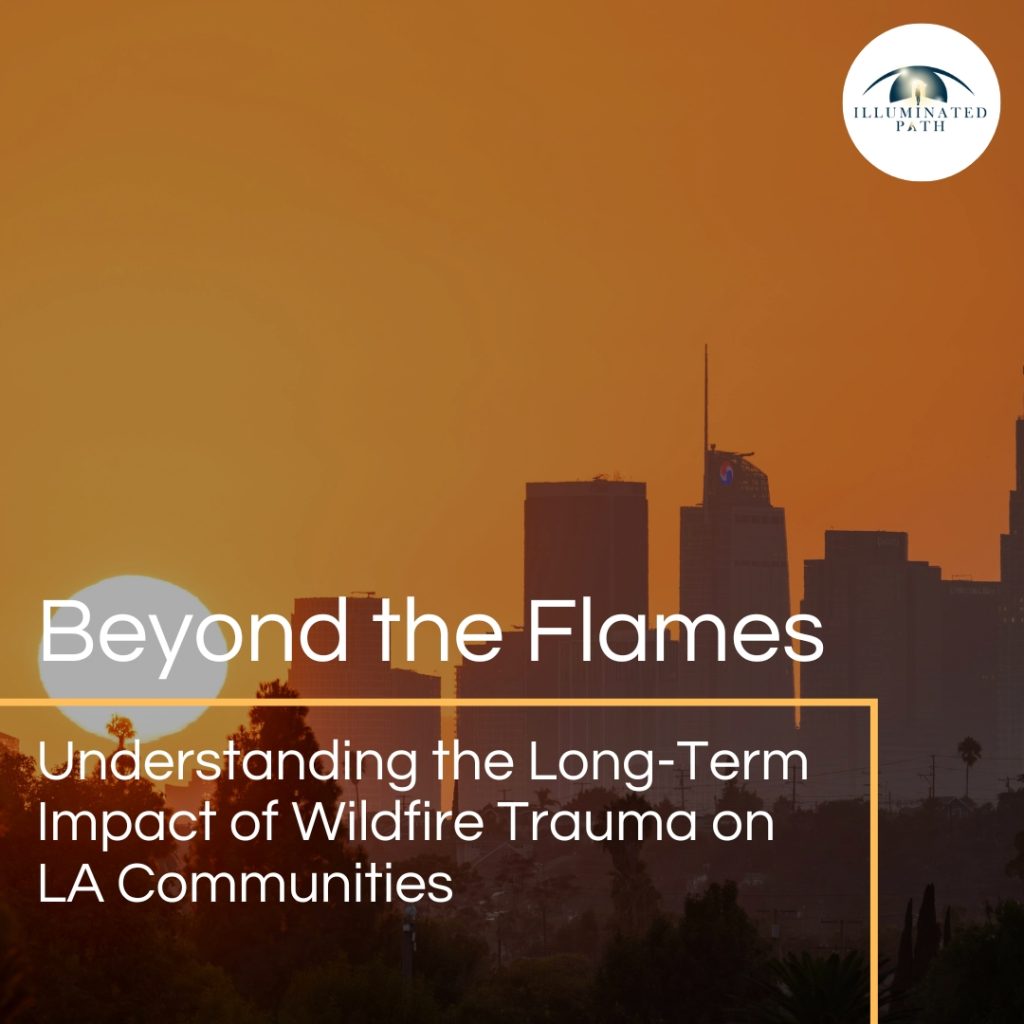
The iconic image of Los Angeles is often one of sunshine, beaches, and Hollywood glamour. But in recent years, a new and terrifying image has emerged: raging wildfires tearing through hillsides, homes, and lives. While the immediate devastation of these fires is undeniable, the long-term impact of wildfire trauma on LA communities is a complex and often invisible wound that demands attention. Beyond the immediate loss of life, homes, and property, wildfires leave a deep psychological scar on individuals and communities. The trauma of witnessing the destruction, fearing for one’s life, and experiencing displacement can have profound and lasting effects on mental health, social connections, and overall well-being. Understanding the nature and scope of this trauma is crucial for providing effective support, fostering resilience, and building stronger communities in the face of future fire threats. The Psychological Impact of Wildfires: More Than Just PTSD While Post-Traumatic Stress Disorder (PTSD) is often associated with wildfire trauma, the psychological impact extends far beyond this single diagnosis. Wildfires can trigger a range of mental health challenges, including: Acute Stress Disorder (ASD): This can occur in the immediate aftermath of a traumatic event, characterized by symptoms such as intrusive thoughts, nightmares, flashbacks, avoidance of reminders, and hyperarousal. Generalized Anxiety Disorder (GAD): Wildfires can heighten anxiety levels, leading to excessive worry, restlessness, and difficulty concentrating. Depression: The loss of loved ones, homes, and community can trigger feelings of sadness, hopelessness, and loss of interest in life. Substance Abuse: Some individuals may turn to drugs or alcohol to cope with the emotional distress of wildfire trauma. Adjustment Disorders: Difficulty adjusting to the changes and losses caused by wildfires can lead to significant emotional and behavioral disturbances. It’s important to recognize that these mental health challenges can affect individuals of all ages, including children, first responders, and those with pre-existing mental health conditions. The Ripple Effect: Trauma’s Impact on LA Communities The impact of wildfire trauma extends beyond the individual level, rippling through families, communities, and social systems. Family Strain: Wildfires can disrupt family dynamics, leading to increased conflict, communication difficulties, and challenges in providing support to one another. Community Disruption: The loss of community gathering places, schools, and businesses can disrupt social connections and support networks, leading to feelings of isolation and disconnection. Economic Hardship: The financial burden of rebuilding, replacing lost belongings, and dealing with insurance claims can create significant economic stress for individuals and families. Strain on Resources: Wildfires can overwhelm mental health services and other support systems, leading to long wait times and limited access to care. The Long-Term Toll: Chronic Stress and Health Consequences The psychological and social consequences of wildfire trauma can persist for years, leading to chronic stress and a range of health problems. Chronic Stress: The ongoing stress of dealing with the aftermath of a wildfire can disrupt the body’s stress response system, leading to chronic inflammation, weakened immune function, and increased risk of chronic diseases. Physical Health Problems: Studies have linked wildfire exposure to increased risk of cardiovascular disease, respiratory problems, and even cancer. Mental Health Challenges: Untreated trauma can lead to chronic mental health conditions, such as PTSD, depression, and anxiety, which can significantly impair quality of life. Increased Vulnerability: Trauma survivors may be more vulnerable to future stressors and challenges, leading to a cycle of adversity and difficulty coping. Building Resilience: Strategies for Recovery and Growth While the impact of wildfire trauma is significant, it’s important to remember that resilience and recovery are possible. Individuals, families, and communities can take steps to heal and build stronger foundations for the future. Individual Strategies: Seek Professional Help: Therapy can provide a safe and supportive space to process trauma, develop coping skills, and address mental health challenges. Practice Self-Care: Engaging in activities that promote emotional and physical well-being, such as mindfulness, exercise, and spending time in nature, can help to reduce stress and build resilience. Connect with Others: Building and maintaining strong social connections can provide a sense of belonging and support during difficult times. Focus on Strengths: Identifying and utilizing personal strengths and resources can foster a sense of agency and empowerment. Community Strategies: Trauma-Informed Care: Implementing trauma-informed practices in schools, healthcare settings, and community organizations can create supportive environments for healing and recovery. Community Support Groups: Providing opportunities for survivors to connect with others who have shared similar experiences can foster a sense of community and reduce isolation. Resilience Building Programs: Investing in programs that promote resilience, coping skills, and disaster preparedness can help communities to better withstand future challenges. Advocacy and Policy Change: Advocating for policies that address climate change, wildfire prevention, and mental health support can create systemic change and reduce the impact of future wildfires. The Path Forward: Embracing Hope and Collective Action The long-term impact of wildfire trauma on LA communities is a complex and multifaceted challenge. However, by understanding the nature of this trauma, investing in resilience-building strategies, and embracing a collective approach to healing and recovery, we can empower individuals, strengthen communities, and create a more hopeful future in the face of fire. The flames may leave scars, but they cannot extinguish the human spirit. By working together, we can help LA communities to rise from the ashes, stronger and more resilient than ever before. The Author Dr. Shadi Souferian Psy. D. Licensed Clinical Psychologist Therapist And Psychologist in Los Angeles And Beverly Hills. You might also enjoy this article: Beyond the Flames: Understanding the Long-Term Impact of Wildfire Trauma on LA Communities February 18, 2025Trauma Anxiety. It’s a word that’s become increasingly commonplace in our everyday conversations, a feeling that…Read more Breaking Free from Anxiety: A Path to Well-being February 10, 2025Personal DevelopmentTrauma Anxiety. It’s a word that’s become increasingly commonplace in our everyday conversations, a feeling that…Read more Energy Psychology: Bridging Ancient Wisdom and Modern Science for Holistic Healing February 5, 2025Personal Development The Rising Demand for Alternative Mental Health Solutions Mental health disorders affect over 970 million…Read more Finding the Way Back to Connection: How Therapy Fosters
Breaking Free from Anxiety: A Path to Well-being
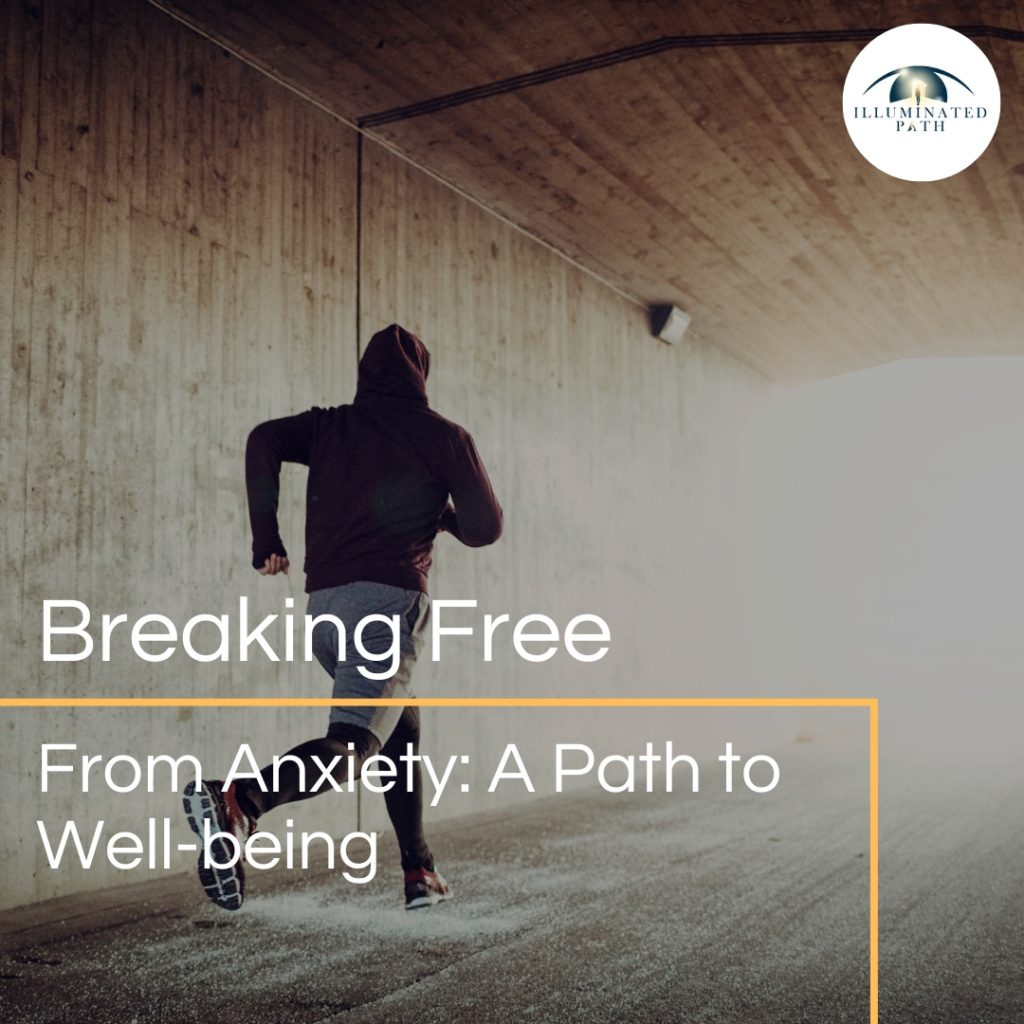
Anxiety. It’s a word that’s become increasingly commonplace in our everyday conversations, a feeling that many of us know all too well. But what exactly is anxiety, and how can we distinguish between the normal anxieties of life and a disorder that requires attention? At its core, anxiety is a natural human response to stress or perceived threat. It’s that feeling of unease, worry, or fear that we experience when faced with a challenging situation. In moderate amounts, anxiety can be beneficial, motivating us to take action and prepare for challenges. However, when anxiety becomes excessive, persistent, and interferes with our daily lives, it can signal an anxiety disorder. The Prevalence of Anxiety Disorders: A Global Concern Anxiety disorders are among the most common mental health conditions worldwide. According to the World Health Organization (WHO), an estimated 301 million people globally were living with an anxiety disorder in 2019, with women being disproportionately affected. (Source: WHO, Mental Health in a world of inequality: Report. 2021.) This number has likely risen since the COVID-19 pandemic, which introduced new stressors and uncertainties into people’s lives. In the United States, data from the National Institute of Mental Health (NIMH) reveals that an estimated 19.1% of U.S. adults experienced an anxiety disorder in any given year. (Source: NIMH, Anxiety Disorders. 2023). This highlights the significant impact of anxiety on individuals, families, and communities. These disorders manifest in various forms, including Generalized Anxiety Disorder (GAD), characterized by excessive worry about everyday events; Panic Disorder, involving recurrent panic attacks; Social Anxiety Disorder (SAD), marked by intense fear of social situations; Specific Phobias, involving fear of specific objects or situations; and Separation Anxiety Disorder, characterized by anxiety about separation from loved ones. Understanding the Roots of Anxiety Anxiety disorders are complex, and their development is influenced by a combination of factors. Genetics can play a role, with research suggesting that anxiety disorders can run in families. Brain chemistry imbalances, particularly in neurotransmitters like serotonin and norepinephrine, can also contribute. Life experiences, such as traumatic events or stressful circumstances, can trigger or worsen anxiety. Additionally, learned behaviors and personality traits, like neuroticism and perfectionism, can increase vulnerability. Recognizing the Symptoms Anxiety manifests in diverse ways, affecting individuals physically, emotionally, and behaviorally. Physical symptoms may include a rapid heartbeat, sweating, trembling, shortness of breath, muscle tension, headaches, fatigue, and sleep disturbances. Emotionally, anxiety can manifest as excessive worry, restlessness, irritability, feeling overwhelmed, fear of losing control, and difficulty concentrating. Behaviorally, it can lead to avoidance of situations, procrastination, social withdrawal, restlessness, and difficulty with daily tasks. The Impact of Anxiety on Daily Life Anxiety disorders can significantly impact an individual’s quality of life. They can strain relationships, leading to conflict and isolation. Anxiety can also impair concentration and productivity, affecting work or school performance. Chronic anxiety can contribute to physical health problems, including cardiovascular disease and digestive issues. Socially, anxiety can lead to withdrawal and difficulty engaging in activities. Seeking Help and Managing Anxiety The good news is that anxiety disorders are treatable. Effective options include psychotherapy, such as Cognitive Behavioral Therapy (CBT), which helps individuals identify and change negative thought patterns and behaviors. Medication, including antidepressants and anti-anxiety drugs, can also be helpful. Lifestyle changes, like regular exercise, a healthy diet, and sufficient sleep, can contribute to anxiety reduction. Mindfulness and relaxation techniques, such as meditation, deep breathing, and yoga, can promote calmness and reduce anxiety. The Importance of Anxiety Awareness Raising awareness about anxiety disorders is crucial for several reasons. It helps reduce stigma, encouraging people to seek help without shame. Early intervention is key to preventing anxiety from becoming chronic, and awareness promotes mental health literacy, empowering individuals to recognize symptoms. Creating supportive environments in families, schools, and workplaces can help individuals with anxiety feel safe and understood. Anxiety is a common human experience, but it doesn’t have to control your life. With awareness, understanding, and appropriate support, you can learn to manage anxiety and live a fulfilling life. The Author Dr. Shadi Souferian Psy. D. Licensed Clinical Psychologist Therapist And Psychologist in Los Angeles And Beverly Hills. You might also enjoy this article: Breaking Free from Anxiety: A Path to Well-being February 10, 2025Personal DevelopmentTrauma Parenting is often described as one of the most rewarding and challenging roles in life.…Read more Energy Psychology: Bridging Ancient Wisdom and Modern Science for Holistic Healing February 5, 2025Personal Development The Rising Demand for Alternative Mental Health Solutions Mental health disorders affect over 970 million…Read more Finding the Way Back to Connection: How Therapy Fosters Deeper Relationships With Self and Others January 29, 2025Life TransformationRelationship “In therapy, we are trying to help people feel more connected to themselves and others.”…Read more Healing Hearts, Building Bridges: Nurturing Relationships After Trauma January 23, 2025Trauma Trauma, whether a singular event or a series of ongoing experiences, can leave deep scars…Read more The Power of Cogmed : Unlocking Better Cognitive and Noncognitive Outcomes for Children January 10, 2025Parenting Working memory (WM) is a cornerstone of cognitive functioning, allowing individuals to temporarily hold and…Read more Bridging the Gap: Navigating Parenting Style Differences in Blended Families January 6, 2025Parenting Blended families are on the rise, with an estimated 16% of U.S. children living in…Read more
Energy Psychology: Bridging Ancient Wisdom and Modern Science for Holistic Healing
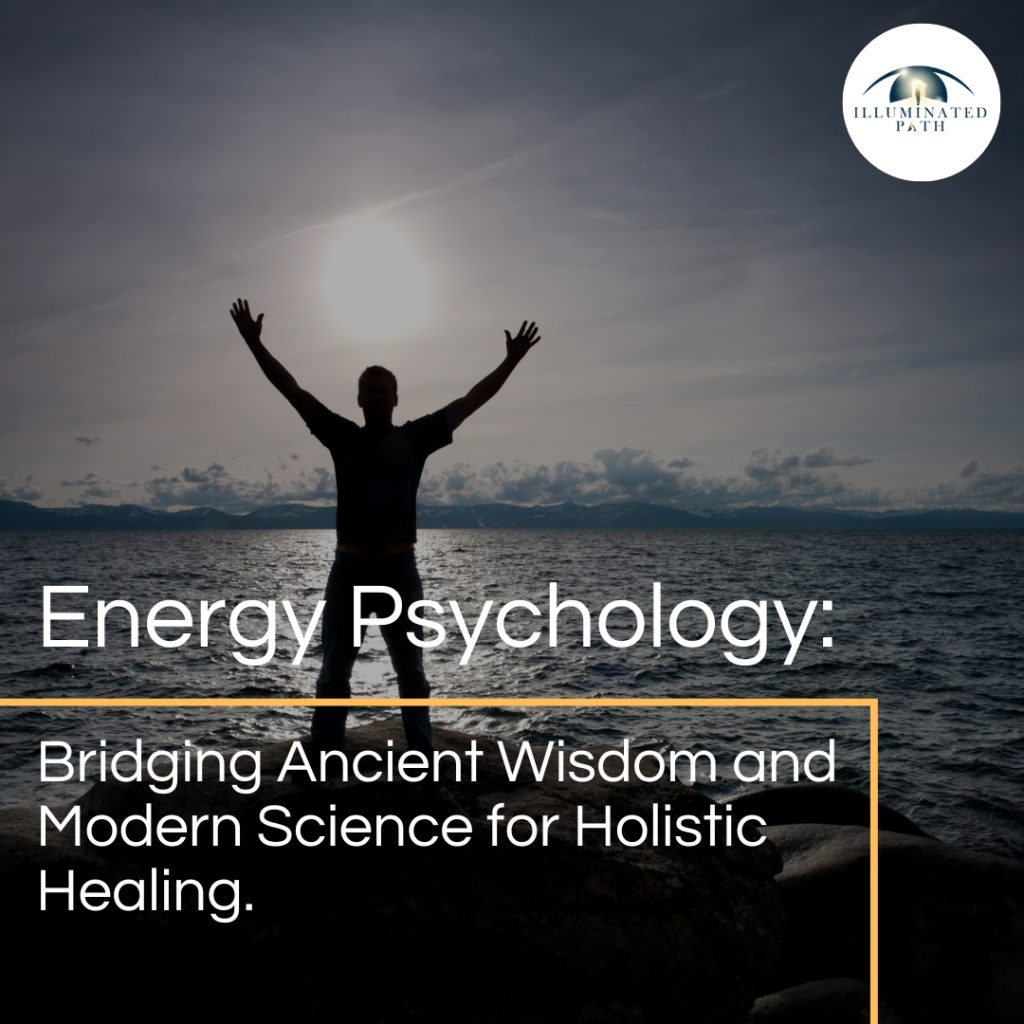
The Rising Demand for Alternative Mental Health Solutions Mental health disorders affect over 970 million people globally, according to the World Health Organization (2022), with anxiety and depression alone costing the global economy an estimated $1 trillion annually in lost productivity. Despite the widespread use of traditional therapies like cognitive behavioral therapy (CBT) and pharmaceuticals, up to 50% of patients experience limited relief or relapse, as noted by the American Psychological Association (2021). This gap in effective treatment has spurred growing interest in integrative approaches, including energy psychology (EP)—a practice that merges cognitive techniques with interventions targeting the body’s subtle energy systems. Offering accessible and non-invasive tools for emotional well-being, EP has gained significant traction in recent years. By 2023, a National Institutes of Health (NIH) survey found that 1 in 5 Americans had tried energy-based therapies like Emotional Freedom Techniques (EFT) for mental wellness. This article delves into the principles, scientific evidence, applications, and debates surrounding energy psychology, offering a comprehensive exploration of its role in modern mental health care. What Is Energy Psychology? Energy psychology is rooted in the idea that disruptions in the body’s biofields—subtle energy systems such as meridians (from Traditional Chinese Medicine) or chakras (from Ayurvedic traditions)—correlate with psychological and physical ailments. By modulating these energy systems, practitioners aim to alleviate emotional distress and promote healing. Modern EP techniques include Emotional Freedom Techniques (EFT), which involves tapping on acupuncture points while focusing on negative emotions; Thought Field Therapy (TFT), which uses algorithm-based tapping sequences to neutralize trauma; and HeartMath, a practice that regulates heart rhythms to improve emotional coherence. At its core, energy psychology operates on three principles: Energy Systems Influence Mental Health: The body’s energy pathways are seen as conduits for emotional and physical well-being. Mind-Body Connection: Psychological trauma is believed to manifest as blockages or imbalances in these energy systems. Rapid Intervention: EP often claims to achieve faster results than traditional talk therapies, with some techniques requiring just minutes to reduce acute stress. Scientific Evidence: What Does the Data Say? The efficacy of energy psychology has been a subject of both enthusiasm and skepticism. Clinical studies, however, are increasingly validating its potential. For example, a 2022 meta-analysis published in the Journal of Nervous and Mental Disease reviewed 56 studies on EFT and found that the technique reduced anxiety symptoms by 40–60% within 4–10 sessions—a result comparable to CBT. Similarly, a randomized trial in the Energy Psychology Journal (2021) demonstrated that EFT decreased depression scores by 39%, compared to a 17% reduction in control groups. Neurological research has also begun to uncover mechanisms behind EP’s effects. Functional MRI studies reveal that EFT significantly reduces hyperactivity in the amygdala, the brain’s fear center, by approximately 25% post-treatment (Frontiers in Psychology, 2021). HeartMath techniques, which focus on heart rhythm coherence, have been shown to increase heart rate variability (HRV)—a biomarker of emotional resilience—by 20–30% (American Journal of Cardiology). Critics, however, argue that EP’s benefits may stem from placebo effects, general relaxation, the therapeutic alliance, or the power of focused attention, rather than energy modulation alone. A 2022 review in Skeptical Inquirer emphasized the need for more rigorous, long-term studies, as most research tracks outcomes for less than a year. Applications in Modern Mental Health Energy psychology’s versatility has led to its adoption in diverse settings. In trauma recovery, for instance, veterans with PTSD experienced a 58% reduction in symptoms after six EFT sessions, according to a 2023 study in the Journal of Military Medicine. The Association for Comprehensive Energy Psychology (ACEP) now trains clinicians in EP techniques specifically for trauma treatment. In corporate wellness programs, companies like Google have integrated HeartMath into their “Search Inside Yourself” curriculum, reporting a 32% drop in employee stress levels. EP is also gaining traction in chronic illness care: a 2021 study in Cancer Care found that 41% of oncology patients using energy psychology reported improved coping skills during chemotherapy. Furthermore, many individuals are exploring EP techniques for self-help and personal growth, utilizing resources like books, online courses, and workshops. Case Studies: Real-World Impact The transformative potential of energy psychology is illustrated through individual stories. In one case, a 35-year-old woman with debilitating social anxiety stemming from childhood bullying used EFT for eight weeks, reducing her Liebowitz Anxiety Scale score from 84 to 42—a threshold indicating clinical remission. Another example involves a veteran with combat-related PTSD who participated in a VA Hospital study using Thought Field Therapy; after six sessions, he experienced a 70% decrease in flashbacks and hypervigilance. Ethical Considerations and Training As energy psychology grows in popularity, ethical concerns around practitioner training and evidence-based integration have emerged. Reputable organizations like ACEP require practitioners to complete 200+ hours of specialized training, ensuring adherence to clinical standards. Notably, 14% of U.S. mental health clinics now combine EP with CBT, according to a 2023 Psychology Today report, reflecting its gradual acceptance into mainstream care. Criticisms and the Path Forward Skeptics often dismiss energy psychology as pseudoscience, citing its reliance on concepts like “biofields,” which lack empirical measurement. However, institutions like the American Psychological Association have begun recognizing EFT as an “emerging treatment” for trauma, signaling a shift toward openness. Future research must address gaps in long-term efficacy data and standardize protocols to strengthen EP’s credibility. A New Frontier in Integrative Care Energy psychology represents a compelling fusion of ancient wisdom and modern neuroscience, offering accessible, low-cost tools for mental health. With growing evidence of its efficacy and 68% of users reporting satisfaction in NIH surveys, its potential to complement traditional therapies is undeniable. By addressing the interconnectedness of mind, body, and emotions, EP offers a holistic approach to healing and well-being. As research evolves, energy psychology may play a pivotal role in addressing the global mental health crisis, bridging the gap between mind, body, and spirit in ways that resonate with our understanding of well-being. The Author Dr. Shadi Souferian Psy. D. Licensed Clinical Psychologist Therapist And Psychologist in Los Angeles And Beverly Hills.
Lost Homes, Lost Hope? Navigating Grief and Loss After the LA Fires
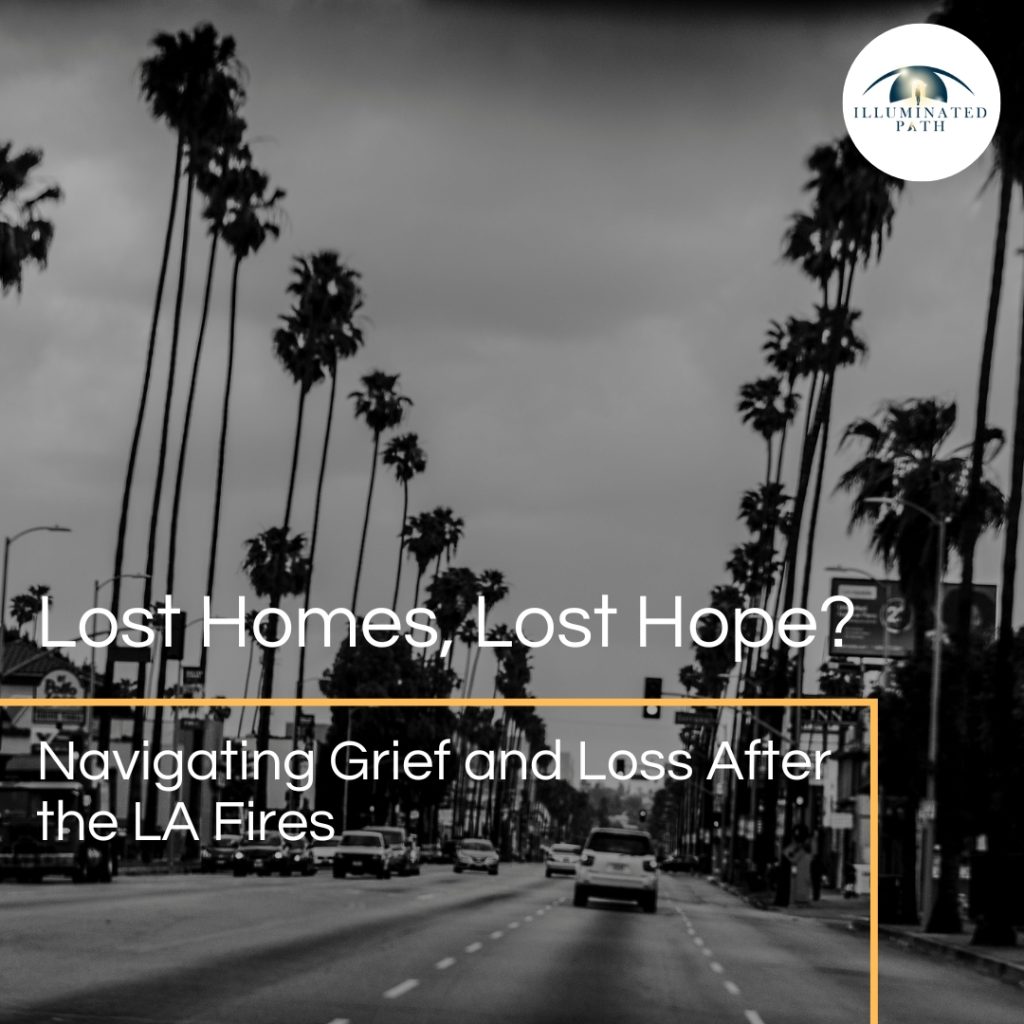
The acrid smell of smoke, the orange glow against the night sky, the frantic scramble for safety – these are the searing memories etched into the minds of those who have lived through the devastating wildfires that have ravaged Los Angeles in recent years. While the physical scars on the landscape may eventually heal, the emotional wounds of loss run deep, leaving individuals and communities grappling with grief, displacement, and a profound sense of disorientation. Losing one’s home to a wildfire is a uniquely traumatic experience. It’s not just the loss of a physical structure; it’s the loss of a sanctuary, a repository of memories, a symbol of stability and security. It’s the loss of a sense of place, of belonging, of identity. Navigating this complex grief requires understanding, compassion, and a multifaceted approach to healing and recovery. The Magnitude of Loss: Statistics Paint a Grim Picture The statistics on wildfire-related losses in Los Angeles paint a stark picture of the devastation faced by individuals and communities. The Woolsey Fire in 2018 burned nearly 97,000 acres, destroyed over 1,600 structures, and resulted in three fatalities. (Source: CAL FIRE) The Getty Fire in 2019 burned over 745 acres, destroying 12 homes and damaging five others. (Source: LAFD) And the Bobcat Fire in 2020 burned over 115,796 acres, destroying 171 structures and damaging 47 others. (Source: Angeles National Forest) These numbers represent not just property damage, but the shattering of lives, the disruption of communities, and the profound emotional toll of losing one’s home and sense of place. The Complexities of Grief After Wildfire Grief after a wildfire is a complex and multifaceted experience. It’s not just the loss of the physical home; it’s the loss of cherished memories and belongings. Homes hold a lifetime of memories, from childhood photos to treasured heirlooms. These tangible reminders of the past are often irreplaceable, leaving a void that can be difficult to fill. Losing a home also shatters one’s sense of security and stability. Home represents a safe haven, a place of comfort. This loss can trigger feelings of vulnerability, anxiety, and fear. Furthermore, wildfires can disrupt the social fabric of neighborhoods and communities, which provide a sense of belonging and support. This can leave individuals feeling isolated and alone. Our homes are often intertwined with our sense of self and our connection to a particular place. Losing this connection can lead to feelings of disorientation and a loss of identity. For many, their home represents their dreams and aspirations for the future. Losing this symbol of hope can be particularly devastating. The Stages of Grief: A Roadmap, Not a Straight Line While grief is a unique and personal experience, it often follows a general pattern of stages, as outlined by Elisabeth Kübler-Ross in her seminal work “On Death and Dying.” These stages include denial, anger, bargaining, depression, and acceptance. It’s important to remember that these stages are not linear, and individuals may experience them in different orders or revisit stages multiple times. Grief is a journey, not a destination, and there is no right or wrong way to grieve. Navigating the Challenges: Coping with Grief and Loss Coping with the grief and loss after a wildfire requires a multifaceted approach that addresses the emotional, psychological, and practical challenges. Emotionally and psychologically, it’s crucial to acknowledge and validate the full range of emotions without judgment. Seeking professional help through therapy can provide a safe space to process these emotions and develop coping skills. Connecting with others, whether it’s friends, family, or support groups, can offer a sense of connection and validation during this difficult time. Practicing self-care through activities like mindfulness, exercise, and spending time in nature can also help reduce stress and foster resilience. On a practical level, it’s important to access community resources. Connect with local organizations and government agencies that offer assistance with housing, financial aid, and other needs. Engaging in the process of rebuilding your home and community can provide a sense of purpose and hope. Creating new rituals and traditions can help honor memories and establish a sense of continuity with the past. While acknowledging the pain of the past, it’s essential to focus on creating a new future filled with hope and possibility. Rebuilding Hope: Finding Meaning and Purpose After Loss While the loss of a home can be devastating, it can also be an opportunity for growth, transformation, and the discovery of new meaning and purpose. Research suggests that individuals can experience positive psychological changes after trauma, such as increased resilience, greater appreciation for life, and stronger relationships. This is known as post-traumatic growth. The experience of loss can prompt individuals to re-evaluate their priorities, discover new passions, and find new ways to contribute to their communities. Wildfires can also bring communities together, fostering a sense of shared purpose and collective resilience. The Role of Community: Healing Together Healing from wildfire trauma is not just an individual journey; it’s a collective effort. Communities play a vital role in supporting individuals and families through grief and loss by fostering a culture of empathy and understanding. This can help individuals feel safe and supported as they navigate their grief. Providing resources and services, such as access to mental health services, financial assistance, and practical support, can be instrumental in helping individuals and families rebuild their lives. Creating opportunities for community gatherings, events, and activities can help to rebuild social connections and foster a sense of belonging. Sharing stories of resilience, celebrating community strengths, and focusing on the future can inspire hope and empower individuals to move forward. Conclusion: From Loss to Renewal Losing a home to a wildfire is a profound loss, but it does not have to extinguish hope. By acknowledging the complexities of grief, accessing support, and embracing a community-oriented approach to healing, individuals and communities can navigate the challenges, rebuild their lives, and find new meaning and purpose in the aftermath of the flames. The journey from loss
Finding the Way Back to Connection: How Therapy Fosters Deeper Relationships With Self and Others
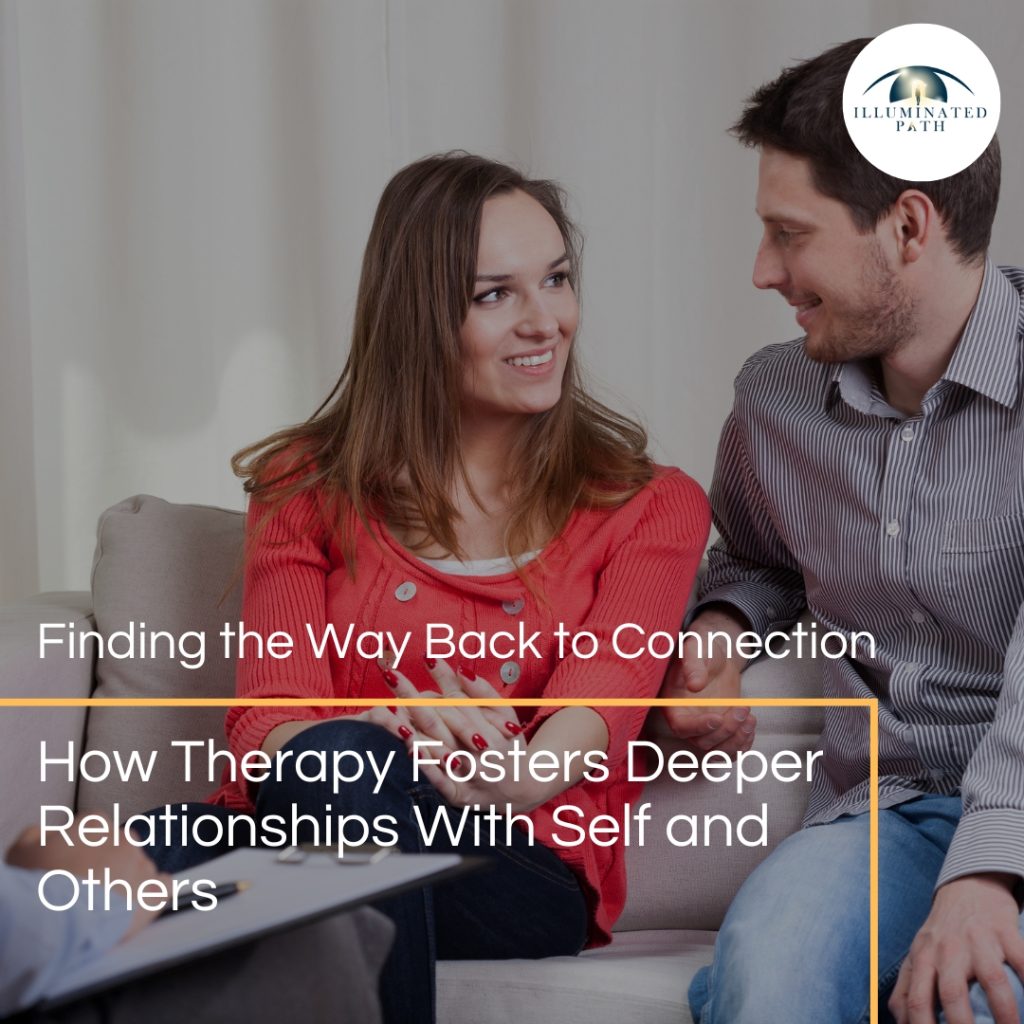
“In therapy, we are trying to help people feel more connected to themselves and others.” – Sue Johnson This insightful quote from Dr. Sue Johnson, a renowned clinical psychologist and developer of Emotionally Focused Therapy (EFT), perfectly captures a fundamental truth about the human experience: we are wired for connection. Our brains are intricately designed to seek out and thrive in relationships, and when these connections are fractured or absent, we suffer deeply. Therapy, in its many forms, offers a pathway back to this essential connection. It provides a safe and supportive space to explore the barriers that prevent us from experiencing genuine intimacy with ourselves and others, and to develop the skills necessary to build and maintain healthy relationships. The Science of Connection The need for connection is not merely a social construct; it is deeply rooted in our biology. Research in neuroscience and attachment theory has revealed the profound impact that relationships have on our physical and mental well-being. Attachment theory, pioneered by John Bowlby and Mary Ainsworth, proposes that our early childhood experiences with caregivers shape our internal working models of relationships, influencing how we connect with others throughout our lives. Secure attachment, characterized by feelings of safety and trust, fosters emotional regulation, resilience, and healthy relationships. In contrast, insecure attachment, often stemming from early experiences of neglect or trauma, can lead to difficulties with intimacy, trust, and emotional regulation. (Source: Bowlby, J. (1969). Attachment and Loss, Vol. 1: Attachment.) Furthermore, advances in neuroscience have illuminated the neural mechanisms underlying connection. The discovery of mirror neurons, which fire both when we perform an action and when we observe someone else performing the same action, suggests that our brains are wired for empathy and understanding others. Moreover, the release of oxytocin, often referred to as the “love hormone,” during social interactions promotes feelings of trust, bonding, and well-being. (Source: Rizzolatti, G., & Craighero, L. (2004). The mirror-neuron system. Annual Review of Neuroscience, 27, 169-192.) Social psychology research consistently demonstrates the detrimental effects of social isolation and loneliness on mental and physical health. Loneliness has been linked to an increased risk of depression, anxiety, cardiovascular disease, and even premature death. Conversely, strong social connections are associated with greater happiness, resilience, and longevity. (Source: Holt-Lunstad, J., Smith, T. B., & Layton, J. B. (2010). Social relationships and mortality risk: A meta-analytic review. PLoS Medicine, 7(7), e1000316.) Disconnection: The Root of Suffering When our need for connection is unmet, or when our relationships are characterized by conflict, insecurity, or trauma, we experience a profound sense of disconnection. This disconnection can manifest in various ways, such as disconnection from self, disconnection from others, and disconnection from the world. Trauma, neglect, or societal pressures can lead to a disowning of parts of ourselves. We may disconnect from our emotions, needs, or authentic selves in an attempt to protect ourselves from pain or rejection. This can lead to feelings of emptiness, shame, and a lack of purpose. Insecure attachment, past hurts, or communication difficulties can create barriers to intimacy and connection with others. We may struggle with trust, vulnerability, or expressing our needs, leading to isolation, conflict, and unsatisfying relationships. A sense of disconnection can also extend to a feeling of alienation from the world around us. We may feel lost, hopeless, or unable to find meaning or purpose in life. This disconnection lies at the root of much human suffering, fueling depression, anxiety, addiction, and a host of other mental and physical health problems. Therapy as a Path to Reconnection Therapy, in its various forms, offers a powerful antidote to disconnection. It provides a safe and supportive space to explore and heal past wounds, develop self-awareness, improve communication skills, build trust and intimacy, cultivate self-compassion, and find meaning and purpose. Therapy can help individuals process past traumas, explore the roots of insecure attachment, and address unresolved emotional pain that may be hindering their ability to connect. It fosters greater awareness of one’s thoughts, feelings, needs, and behaviors. This increased self-understanding allows individuals to connect with their authentic selves and make choices that are aligned with their values. Therapy can also help individuals develop effective communication skills, including active listening, assertiveness, and expressing emotions in a healthy way. These skills are essential for building and maintaining healthy relationships. By identifying and overcoming barriers to trust and intimacy, such as fear of vulnerability or past betrayals, therapy can help individuals build deeper connections with others. Moreover, therapy encourages self-compassion, which involves treating oneself with kindness, understanding, and acceptance. This allows individuals to heal from past hurts and develop a more positive and loving relationship with themselves. Finally, therapy can help individuals explore their values, passions, and goals, and to find meaning and purpose in their lives. This sense of purpose can foster a deeper connection to oneself and the world around them. Different Therapeutic Approaches to Fostering Connection Different therapeutic approaches offer unique perspectives and techniques for fostering connection. Some of the most common include Emotionally Focused Therapy (EFT), Cognitive Behavioral Therapy (CBT), Psychodynamic Therapy, Mindfulness-Based Therapies, and Somatic Experiencing. EFT, developed by Sue Johnson, focuses on the emotional bond between partners and helps them to identify and change negative interaction patterns that contribute to disconnection. It emphasizes the importance of emotional responsiveness and accessibility in creating secure attachment. (Source: Johnson, S. M. (2004). The practice of emotionally focused couple therapy: Creating connection. Routledge.) CBT helps individuals identify and challenge negative thought patterns and behaviors that contribute to depression, anxiety, and relationship problems. It focuses on developing coping skills and changing unhelpful behaviors to improve emotional regulation and interpersonal effectiveness. (Source: Beck, A. T. (1976). Cognitive therapy and the emotional disorders. International Universities Press.) Psychodynamic therapy explores the unconscious processes that influence thoughts, feelings, and behaviors. It often focuses on early childhood experiences and relationships to understand current patterns of relating. (Source: Gabbard, G. O. (2014). Psychodynamic psychiatry in clinical practice. American
Healing Hearts, Building Bridges: Nurturing Relationships After Trauma
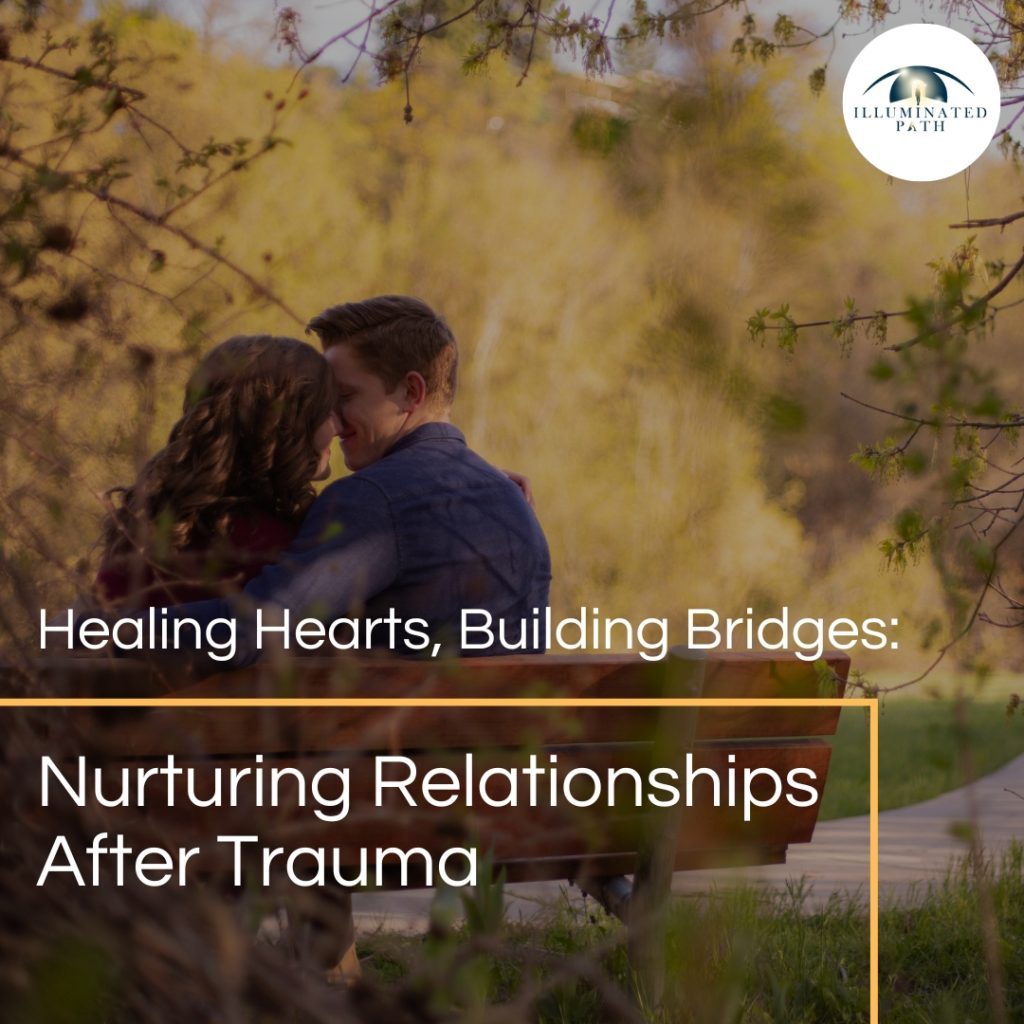
Trauma, whether a singular event or a series of ongoing experiences, can leave deep scars on an individual’s life. These wounds extend beyond the emotional and mental realm, often impacting the ability to form and maintain healthy relationships. The invisible burden of trauma can create obstacles to intimacy, trust, and open communication, making it challenging to connect with others on a profound level. But with understanding, support, and the right tools, it’s entirely possible to heal from trauma and cultivate fulfilling relationships. Understanding How Trauma Affects Relationships Trauma manifests in diverse ways, and its effects on relationships are equally varied. Some common hurdles faced by individuals and couples dealing with trauma include: Struggling with Trust and Intimacy: Trauma can chip away at trust in oneself and others, making it difficult to feel safe and vulnerable in close relationships. Survivors may find emotional intimacy challenging, fearing that opening up will lead to more pain or rejection. Communication Barriers: Trauma can disrupt communication patterns, hindering the ability to express needs and boundaries effectively. Survivors may grapple with emotional regulation, leading to outbursts, withdrawal, or difficulty understanding their partner’s emotions. Conflict and Triggered Reactions: Past trauma can be triggered by seemingly harmless events in the present, leading to heightened emotional responses and conflict. Survivors may react in ways that seem out of proportion to the situation, leaving their partners feeling confused and hurt. Repeating Trauma Patterns: Unresolved trauma can lead to unconscious behaviors that recreate past traumatic experiences in current relationships. This might manifest as seeking out partners who resemble abusers or engaging in self-sabotaging behaviors. Isolation and Withdrawal: Trauma can foster feelings of isolation and disconnection, making it difficult to seek support or engage in social activities. Survivors may withdraw from relationships to avoid triggering situations or feeling overwhelmed. The Prevalence of Trauma’s Impact on Relationships The impact of trauma on relationships is a significant concern, and research underscores the prevalence of these challenges: Adverse Childhood Experiences (ACEs): The groundbreaking ACEs study revealed a strong link between childhood trauma and a range of negative outcomes in adulthood, including relationship difficulties, divorce, and intimate partner violence. (Source: Felitti et al., 1998) Intimate Partner Violence (IPV): Trauma is a major risk factor for both perpetrating and experiencing IPV. Survivors of childhood abuse are more likely to experience IPV in adulthood, and IPV itself can be a deeply traumatizing experience. (Source: Centers for Disease Control and Prevention) Mental Health Disorders: Trauma significantly contributes to mental health disorders like PTSD, depression, and anxiety, which can severely impact relationships. Individuals with PTSD are more likely to experience relationship difficulties, including higher rates of divorce and separation. (Source: National Center for PTSD) Rebuilding and Strengthening Relationships After Trauma Healing from trauma and building healthy relationships is a journey that requires patience, self-compassion, and often professional guidance. Here are some key strategies that can help: 1. Seeking Professional Support: Therapy: Trauma-informed therapy offers a safe and supportive environment to process traumatic experiences, develop coping mechanisms, and address relationship challenges. Various therapeutic approaches, such as Cognitive Behavioral Therapy (CBT), Eye Movement Desensitization and Reprocessing (EMDR), and Somatic Experiencing, can be effective in treating trauma. Couples Therapy: If both partners are willing, couples therapy can help address communication issues, rebuild trust, and develop healthier patterns of interaction. Trauma-informed couples therapy can help partners understand the impact of trauma on their relationship and work together to create a more supportive and secure environment. 2. Cultivating Self-Awareness and Self-Compassion: Identifying Triggers: Understanding your triggers and how they affect your behavior can help you manage emotional reactions and communicate more effectively with your partner. Prioritizing Self-Care: Engaging in activities that promote emotional and physical well-being, such as mindfulness, exercise, and spending time in nature, can help regulate emotions and build resilience. Challenging Negative Thoughts: Trauma can lead to negative beliefs about oneself and the world. Challenging these thoughts and replacing them with more positive and realistic ones can improve self-esteem and relationship satisfaction. 3. Fostering Communication and Trust: Open and Honest Dialogue: Creating a safe space for open and honest communication is crucial for building trust and intimacy. This involves actively listening to your partner, expressing your needs and boundaries clearly, and being willing to be vulnerable. Non-Violent Communication: Learning non-violent communication techniques can help you express yourself in a way that is respectful and empathetic, even during disagreements. Repairing Relationship Ruptures: Conflict is inevitable in any relationship, but it’s how you repair those ruptures that matters. Apologizing for hurtful behavior, taking responsibility for your actions, and working together to find solutions can strengthen the bond between partners. 4. Establishing Healthy Boundaries: Identifying and Communicating Boundaries: Clearly defining your boundaries and communicating them assertively is crucial for protecting your emotional and physical well-being. Respecting Your Partner’s Boundaries: It’s equally important to respect your partner’s boundaries and be willing to compromise when necessary. Enforcing Boundaries: If your boundaries are violated, it’s important to address the issue directly and take steps to protect yourself. 5. Practicing Patience and Forgiveness: Patience with Yourself: Healing from trauma takes time, and it’s important to be patient with yourself and your partner throughout the process. Forgiveness: Forgiving yourself and others for past hurts can be a powerful step towards healing and moving forward. Focusing on the Present: While it’s important to acknowledge the past, it’s equally important to focus on the present and build a future together. 6. Building a Support Network: Connecting with Others: Spending time with supportive friends and family can provide a sense of connection and belonging. Joining a Support Group: Connecting with others who have experienced trauma can provide a sense of validation and understanding. Engaging in Community Activities: Participating in activities that align with your interests can help you build new relationships and expand your support network. By integrating these strategies, individuals and couples can navigate the complexities of trauma and forge a path toward healing and healthy connection. Remember: Trauma is not your fault. You are not responsible for what happened
The Power of Cogmed : Unlocking Better Cognitive and Noncognitive Outcomes for Children
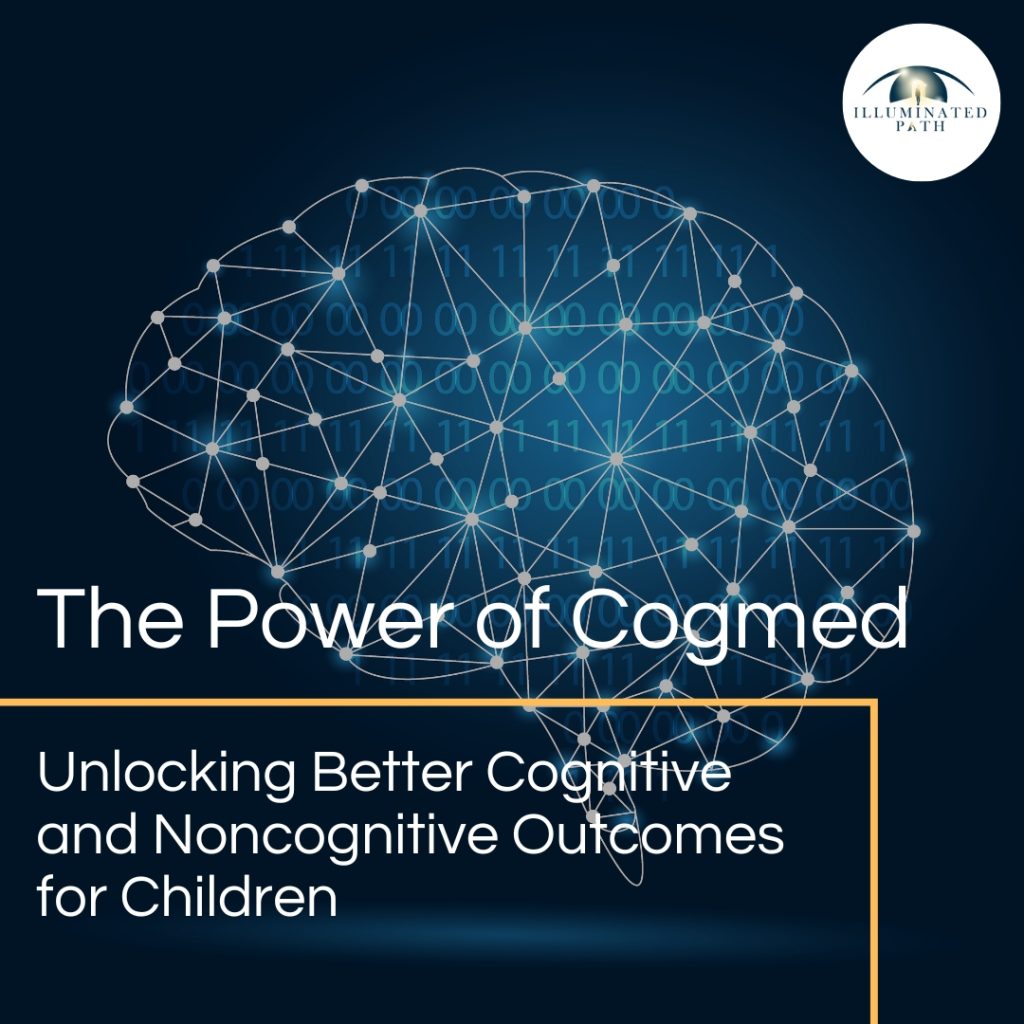
Working memory (WM) is a cornerstone of cognitive functioning, allowing individuals to temporarily hold and manipulate information. It is essential for tasks such as problem-solving, reasoning, and learning, which directly influence academic and social success. In recent years, working memory training programs like Cogmed Working Memory Training (CWMT) have gained attention for their potential to enhance cognitive and noncognitive skills, particularly in children. This article explores how Cogmed impacts these areas, supported by data, statistics, and research findings. What is Cogmed Working Memory Training? Cogmed is a research-based software program designed to improve WM through adaptive and intensive exercises. Developed by Torkel Klingberg and his team at the Karolinska Institute in Sweden, it was initially aimed at improving WM in individuals with ADHD. Over time, its use has expanded to children with learning disabilities, neurodevelopmental disorders, and even those seeking general cognitive enhancement. The program consists of 25 to 30 training sessions, lasting 30 to 45 minutes each, and adjusts task difficulty based on the user’s performance. Core Goals of Cogmed: Enhance short-term memory and the ability to manipulate information. Improve related cognitive functions, such as attention and inhibitory control. Facilitate better academic performance and behavioral regulation. Cognitive Benefits of Cogmed 1. Improvement in Working Memory Capacity Multiple studies have shown that Cogmed significantly improves WM capacity. For example: A meta-analysis of 25 studies conducted by Spencer-Smith and Klingberg (2015) found that Cogmed improved visuospatial and verbal WM in children, with medium to large effect sizes (Cohen’s d = 0.59 for visuospatial and 0.72 for verbal WM). Randomized Controlled Trials (RCTs): Holmes et al. (2009) demonstrated that children aged 8–11 with low WM capacity showed a 23% improvement on WM tasks after completing Cogmed training compared to a control group. 2. Transfer Effects to Academic Skills WM training’s ability to generalize to academic domains has been a topic of significant research. A study by Egeland et al. (2013) showed that children with ADHD who completed Cogmed training improved their performance in math and reading tasks by 15% over six months compared to a control group, which showed no improvement. German Educational Study (2020): A large-scale study involving 580 children found that those who underwent WM training at age six experienced improved math and reading scores by 12% and 9%, respectively, over the following year. 3. Executive Functioning and Cognitive Flexibility Cogmed training strengthens other executive functions, such as cognitive flexibility and inhibitory control: ADHD Study: Klingberg et al. (2005) found that children with ADHD who completed Cogmed showed a 25% improvement in tasks requiring cognitive flexibility, such as shifting between different rules in problem-solving. Inhibitory Control Gains: Research by Chein et al. (2011) revealed that children who underwent Cogmed exhibited enhanced impulse control, scoring 19% better on Go/No-Go tasks compared to non-trained peers. Noncognitive Benefits of Cogmed 1. Improvements in Self-Regulation WM is closely linked to self-regulation, which includes managing emotions, behaviors, and impulses. Cogmed has been shown to benefit these areas: ADHD Symptoms: According to a study by Beck et al. (2010), parents reported a 30% reduction in inattentive and hyperactive behaviors in children with ADHD after completing Cogmed training. Behavioral Regulation: In a classroom setting, children who underwent Cogmed were 18% less likely to engage in disruptive behaviors compared to peers who did not receive training (Holmes et al., 2010). 2. Long-Term Behavioral Changes Long-term follow-up studies suggest that Cogmed’s impact on noncognitive skills can extend years after training: A four-year follow-up of children who participated in Cogmed (Egeland et al., 2013) found that they were 16% more likely to succeed in secondary education tracks requiring high self-regulation, compared to children who did not receive the training. Conclusion Cogmed Working Memory Training offers a structured and evidence-based approach to improving working memory and related skills in children. While its impact on WM capacity and near-transfer effects is well-supported, the extent of far-transfer effects to academic and behavioral domains remains a topic of debate. Nonetheless, research indicates that Cogmed can significantly benefit children with ADHD, learning disabilities, or low baseline WM. Future research should focus on long-term sustainability, cost-effectiveness, and the development of more accessible training methods to ensure broader applicability. Integrating Cogmed into comprehensive educational and developmental strategies may unlock its full potential, paving the way for significant cognitive and noncognitive gains in children. The Author Dr. Shadi Souferian Psy. D. Licensed Clinical Psychologist Therapist And Psychologist in Los Angeles And Beverly Hills. You might also enjoy this article: The Power of Cogmed : Unlocking Better Cognitive and Noncognitive Outcomes for Children January 10, 2025Parenting Working memory (WM) is a cornerstone of cognitive functioning, allowing individuals to temporarily hold and…Read more Bridging the Gap: Navigating Parenting Style Differences in Blended Families January 6, 2025Parenting Blended families are on the rise, with an estimated 16% of U.S. children living in…Read more How Cogmed Therapy Addresses Client Pain Points December 31, 2024Personal Development In our increasingly demanding and dynamic world, working memory is more critical than ever. It…Read more Building Bridges of Loyalty and Affection Through Empathy in Parenting December 24, 2024Parenting Parenting is often described as one of the most rewarding and challenging roles in life.…Read more How Couples Therapy Can Transform Your Relationship (Backed by Research) December 18, 2024Relationship Relationships are at the heart of human experience, offering love, support, and companionship. They provide…Read more The Power of Vulnerability: Building Stronger Relationships Through Emotional Connection December 10, 2024Relationship In a world that often prioritizes self-reliance and emotional stoicism, vulnerability can feel like a…Read more
Bridging the Gap: Navigating Parenting Style Differences in Blended Families
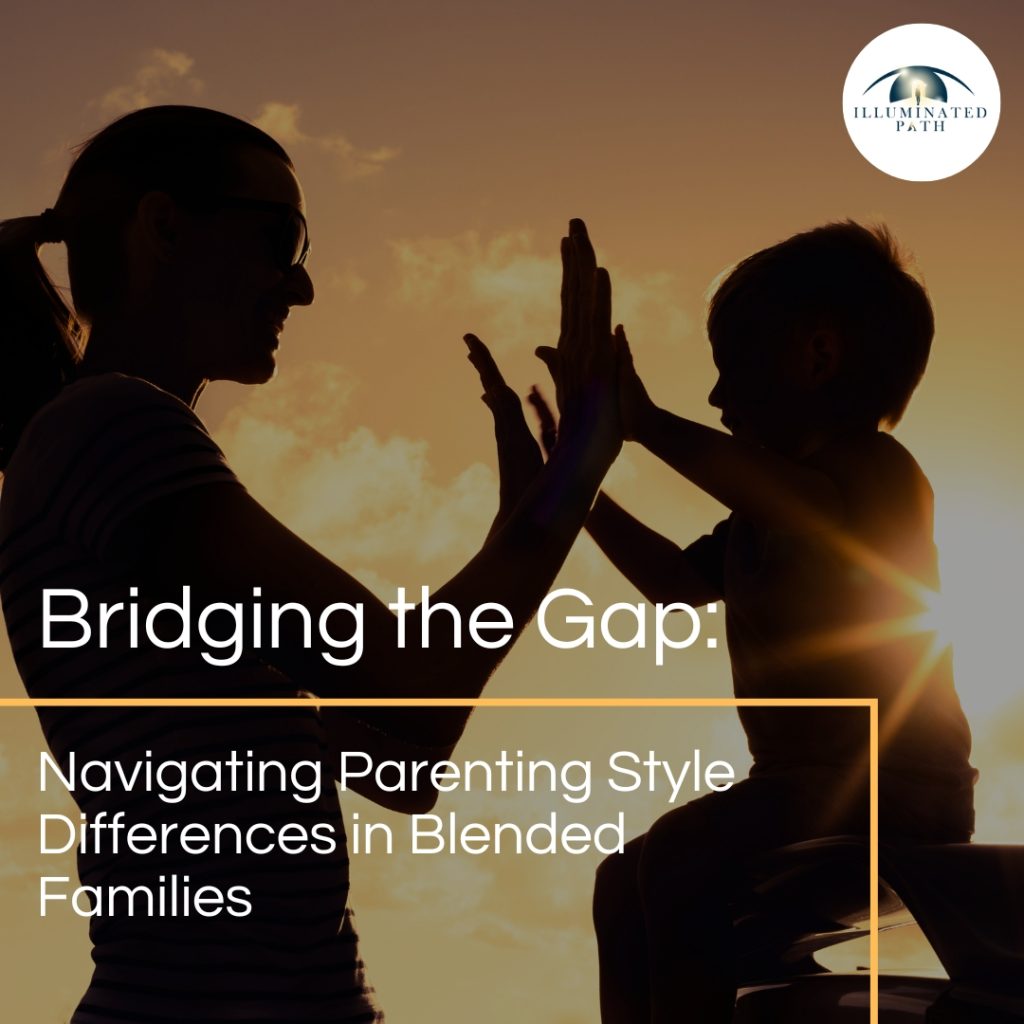
Blended families are on the rise, with an estimated 16% of U.S. children living in stepfamily households, according to the U.S. Census Bureau. While these families offer opportunities for new beginnings and expanded relationships, they also come with unique challenges. Chief among these is the task of reconciling differing parenting styles—a process that requires patience, communication, and flexibility. This article explores the complexities of parenting in blended families, offering data-backed insights and actionable strategies to navigate these differences and create a harmonious family environment. Understanding Parenting Styles in Blended Families Parenting styles are influenced by personal upbringing, cultural backgrounds, and past family dynamics. Blended families bring together individuals with varying approaches to discipline, communication, and emotional support, which can sometimes lead to conflict. The Four Primary Parenting Styles Psychologist Diana Baumrind identified four key parenting styles, each with distinct characteristics: Authoritative: High responsiveness and high expectations. Authoritarian: Low responsiveness and high expectations. Permissive: High responsiveness and low expectations. Neglectful: Low responsiveness and low expectations. In blended families, mismatches in these styles can result in misunderstandings or power struggles. Data on Parenting Conflicts in Blended Families Research highlights the prevalence of parenting conflicts in stepfamilies: 70% of blended families experience disagreements about parenting approaches within the first two years, according to Family Relations (2022). Stepparents report feeling unsure about their role in over 60% of stepfamily dynamics, as noted in a study by the Journal of Family Psychology (2021). These statistics underscore the importance of proactive communication and strategy in addressing parenting style differences. Common Challenges 1. Discipline Discrepancies Discipline is often a flashpoint for conflict in blended families. One parent may favor strict rules and immediate consequences, while the other prefers a more lenient, understanding approach. 2. Role Confusion for Stepparents Stepparents may struggle to find their place in the family, particularly when it comes to discipline and authority. They may feel torn between wanting to bond with the stepchildren and adhering to their partner’s parenting preferences. 3. Perceptions of Favoritism Children in blended families may perceive differences in parenting as favoritism, leading to resentment and tension. This is especially common in families with children from previous relationships. 4. Cultural and Generational Differences Blended families often bring together individuals from different cultural or generational backgrounds, which can influence parenting expectations and practices. Strategies for Navigating Parenting Style Differences 1. Establish Shared Goals One of the most effective ways to align parenting styles is by focusing on shared family objectives. Discuss long-term goals, such as raising respectful, independent, and resilient children, and agree on non-negotiable boundaries. Example: Set household rules around bedtime, screen time, and chores that both parents support. 2. Communicate Openly and Respectfully Regular communication is key to resolving parenting conflicts. Schedule time to discuss parenting strategies without distractions. Tip: Use “I” statements to express concerns without assigning blame. For example, “I feel that consistent discipline helps create stability for the children.” 3. Respect Each Parent’s Role In the early stages of blending families, it’s often best for biological parents to take the lead on discipline while stepparents focus on building trust with the children. Over time, roles can evolve as relationships deepen. Research Insight: A 2020 study in the Journal of Marriage and Family Therapy found that stepparents who prioritized relationship-building in the first year reported stronger bonds with their stepchildren. 4. Present a Unified Front Children benefit from consistency. Even when parents disagree behind closed doors, it’s important to present a united front. This prevents children from exploiting differences and fosters a sense of stability. 5. Seek Professional Guidance Family counseling or parenting workshops can provide valuable tools for navigating conflicts and fostering cohesion in blended families. Professional support can also help parents address underlying issues and improve communication. Addressing Common Misconceptions Misconception 1: Stepparents Should Enforce Discipline Immediately In reality, stepparents often find more success by focusing on relationship-building first. Discipline can be introduced gradually as trust develops. Misconception 2: Parenting Styles Must Be Identical While consistency is important, parents don’t need to adopt identical styles. What matters is aligning on core values and presenting a cohesive approach. Misconception 3: Differences in Parenting Styles Are Harmful Parenting differences can be an opportunity for growth and learning if approached with respect and open communication. The Role of Flexibility in Blended Families Blended families are dynamic by nature, and flexibility is crucial to their success. Parents must be willing to adapt their approaches as circumstances change and as children grow. Quote:“Parenting in a blended family isn’t about eliminating differences; it’s about harmonizing them,” says Dr. Emily Carter, a family psychologist specializing in stepfamily dynamics. Data-Backed Benefits of Resolving Parenting Conflicts When parents in blended families align their approaches, the benefits are clear: Stronger Family Bonds: Families that practice effective communication report a 35% increase in overall satisfaction, according to Family Psychology Today (2021). Improved Child Well-Being: Children in harmonious blended families are 40% less likely to experience anxiety or behavioral issues, as noted by the National Institute on Child Development (2022). Lower Parental Stress: Parents who collaborate effectively experience a 25% reduction in stress, according to Clinical Psychology Review (2020). Conclusion Navigating parenting style differences in blended families can be challenging, but it’s a challenge worth taking on. By fostering open communication, setting shared goals, and respecting each other’s roles, parents can create a stable, loving environment where every family member feels valued. Blended families thrive not by erasing differences but by embracing them as opportunities for growth and connection. With patience, flexibility, and a commitment to unity, families can build strong, lasting bonds that stand the test of time. Sources: Family Relations (2022) Journal of Family Psychology (2021) Journal of Marriage and Family Therapy (2020) National Institute on Child Development (2022) Clinical Psychology Review (2020) The Author Dr. Shadi Souferian Psy. D. Licensed Clinical Psychologist Therapist And Psychologist in Los Angeles And Beverly Hills. You might also enjoy this article: Conscious Parenting: Nurturing Self-Aware Relationships with Your Children January 13, 2025Parenting The Author Dr. Shadi
